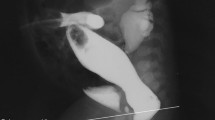Abstract
Rectourethral or rectovaginal fistula is a troublesome complication after anorectal surgery. The pelvic and perineal dissection may be difficult because of severe fibrosis adhesion around the fistula. The authors applied a novel technique: a combined laparoscopic assisted abdominal and posterior sagittal approach (PSA) to perform the redo surgery. Three boys and two girls (3–13 years old): case 1 had rectovaginal fistula after rectal dialation and modified Swenson’s procedure; case 2 had rectovestibular fistula after twice perineal anorectoplasty; case 3 had rectourethral fistula after twice anorectoplasty; case 4 was imperforate anus with Hirschsprung’s disease and rectourethral fistula that had been misdiagnosed; case 5 had rectourethral fistula after abdominoperineoanoplasty and Mollard procedure and posterior sagittal anorectoplasty. Laparoscopic assisted abdominal dissection was done first to mobilize the colon as far as the mid pelvis, and the normal colon was marked with a suture. The lower pelvic dissection was performed through the posterior sagittal route, the proximal rectum was mobilized and servered, the distal rectum was left undisected, endorectal mucosectomy with electric ablation was performed, then the fistula was closed from inside the rectum, and the stump of the colon was pulled through the rectum, the stump and the dentate line were anastomosed extraanally. Colostomy was done in case 2 and case 5. The postoperative follow-up showed no recurrent fistula, and all patients had attained normal voluntary bowel actions, but one child had infrequent minor soiling. Laparoscopic assisted endorectal pull-through of the intact colon can offer precise dissection, minimal abdominal injure, and spare troublesome mobilization of the fistula, and can prevent the recurrent of fistula. Posterior sagittal approach provides a direct repair of the fistula and anastomosis.


Similar content being viewed by others
References
Austoni E, Guarneri A, Colombo F et al (2005) The new transperineal–prerectal approach in posterior urethroplasty. Arch Ital Urol Androl 2:122–124
Garofalo TE, Delaney CP, Jones SM et al (2003) Rectal advancement flap repair of rectourethral fistula: a 20-year experience. Dis Colon Rectum 6:762–769
Venable DD (1989) Modification of the anterior perineal transanorectal approach for complicated prostatic urethrorectal fistula repair. J Urol 142:381–384
Wang G, Li ZD (1999) Pediatric anorectal surgery. Zhongyuan Farmer Publishing Company, Zhengzhou, China, pp 703–708
Pena A, Devries PA (1982) Posterior sagittal anorectoplasty: Important technical considerations and new applications. J Pediatr Surg 17:796–811
Aggarwal SK, Yadav S, Goel D et al (2002) Combined abdominal and posterior sagittal approach for redo pull-through operation in Hirschsprung’s disease. J Pediatr Surg 8:1156–1159
Kubota A, Kawahara H, Okuyama H et al (2003) Endorectal pull-through with posterior sagittal approach to the repair of postoperative rectourethral and rectovaginal fistula. J Pediatr Surg 12:1775–1777
Zmora O,Tulchinsky H, Gur E et al (2006) Gracilis muscle transposition for fistulas between the rectum and urethra or vagina. Dis Colon Rectum 9:1316–1321
Georgeson KE, Cohen RD, Hebra A et al (1999) Primary laparoscopic-assited endorectal colon pull-through for Hirschsprung’s disease. Ann Surg 229:678–683
Georgeson KE, Inge TH, Albaness CT (2000) Laparoscopicall assisted anorectal pull-through for high imperforaye anus a new thchnique. J Pediatr Surg 35:927–931
Tang ST, Cao ZQ, Ruan QL et al (2005) A comparison between laparoscopic pull-through heart-shape coloproctectomy and open pull-through surgery in the treatment of Hirschsprung’s disease. Chin J Min Inv Surg 9:699–701
Tong QS, Tang ST, Ruan QL et al (2005) Laparoscopically assisted anorectoplasty for high imperforate anus. Chin J Pediatr Surg 3:155–156
Pinter A, Hock A, Vastyan AM et al (2007) Posterior sagittal approach with perirectal dissection for reconstructive surgery of severe urogenital anomalies. Pediatr Surg Int 1:57–60
Author information
Authors and Affiliations
Corresponding author
Rights and permissions
About this article
Cite this article
Tang, S., Dong, N., Tong, Q. et al. Laparoscopic assisted endorectal pull-through with posterior sagittal approach to the repair of postoperative rectourethral and rectovaginal fistula. Pediatr Surg Int 23, 1077–1080 (2007). https://doi.org/10.1007/s00383-007-1995-6
Accepted:
Published:
Issue Date:
DOI: https://doi.org/10.1007/s00383-007-1995-6




